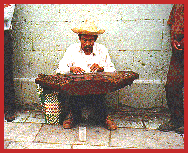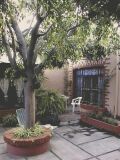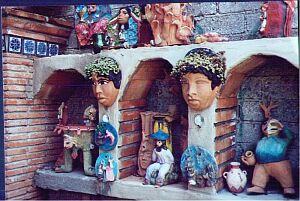
THE OAXACA / MEXICO NEWSLETTER
Volume 5, No. 17: October 15, 2000

|

|
THE OAXACA / MEXICO NEWSLETTER
|

|
SURGERY IN OAXACA, A PERSONAL EXPERIENCE (A "Letter From Oaxaca, México"):
[I wrote this a year ago, but for some reason never published it.]
By the time you read this, the pain should be gone. I mention the pain only because I am a sympathy junky, and am hoping to garner a little from you. The pain itself is the aftermath of a hernia operation. How I came to this juncture in what is by now a five-plus-year saga of my life in Paradise, is, as you may have guessed, the subject of this letter.
I am a paid up member of the National Health Plan provided by the Instituto Mexicana de Seguro Social (IMSS), otherwise known as Seguro Social. I don't have any other insurance, either here or in the U.S., being too young for Medicaid and too poor for private HMO's back home. Seguro Social cost about $330 dollars for a year, (when I renewed my policy in August 2000). Included in the price are free medicines, checkups, etc., so I figure that in the course of a normal year, I about break even on the deal. However, there are certain drawbacks about belonging to the plan, the most frustrating of which is timing: everything takes forever. The other problem crosses over to include both the private and public sectors: the difficulty of getting a correct diagnosis for a non-critical condition.
For over a year, I complained to various doctors about having abdominal pains when lifting, when walking more than a few blocks, when coughing or sneezing. I kept suggesting that possibly a hernia was indicated. Examinations consisted of a glance at the suspect area, but little "hands on" testing, and I was told that there appeared to be nothing wrong. As time went on, things seemed to get worse, but I was tired of having my reality denied, and put off returning to the quacks for several months.
Finally, one day in September, I could feel a lump in the pelvic area that seemed to grow as I stood, and recede as I reclined. I noticed that I could push it down with my finger. It seemed to be getting bigger as the days went on. I consulted my Plan doctor, privately (most have private practices on the side), outside of office hours. Sure enough, he confirmed my diagnosis, and said it was not very large and I needn't worry about it, but should probably make an appointment with his substitute (he was on vacation) and begin the process that would lead, eventually, to surgery.
Next day, I presented myself at the clinic and was referred to the Jefe (chief) of the clinic for an authorization for surgery. He examined me and authorized clinical blood studies, a requirement for all surgeries, but did not refer me to a surgeon. I went to the lab, and was told to come back in ten days -- the best they could do since I did not have a surgery date.
The following day, feeling alarmed at what seemed to me to be a growing lump, I decided to seek advice from a private surgeon, and looked in the phone book for a hernia specialist. There were three. I consulted one, and for the first time got a complete "hands on" exam, at the end of which he described the problem in some detail, including the size (about like an egg), which he said indicated an advanced and possibly dangerous situation. He suggested getting operated on as soon as possible, and named a price of around $1,500 dollars including hospital, anesthesiologist, and after-care. I gulped (that's about three months' income for me), and said I would let him know.
Next I went to another surgeon, who had done a successful double hernia operation for a friend of mine, and only charged about $1,000 dollars. He, too, did a thorough exam, and he, too, pronounced the problem to be advanced and needing immediate attention.
So there I was, in the beginning of what could be a long and fruitless wait for surgery in the public sector (friends have come right up to the moment of surgery -- admitted, prepped, and waiting for the gurney -- and been told that their place had been given to an emergency patient, and that therefore they had to start the whole process over, blood tests, referrals, waiting list and all), with a condition that could, if it really turned bad, lead to peritonitis. I felt like Jack Benny ("Your money or your life". "Wait, I'm thinking..."). What's a poor gringo to do? I decided to bite the financial bullet and get it done.
Next day, I got the blood tests and a chest x-ray done in the morning, presented the surgeon with the results in the afternoon, and was scheduled for admittance the following noon with afternoon surgery.
My surgeon practices in one of several similar facilities spread throughout the central Oaxaca area. It is a clinic/hospital with offices for several doctors, most of whom are specialists of one kind or another, and contains its own diagnostic clinic, drug store, a couple of operating rooms, and beds for perhaps 25 to 35 people.
The day I reported for my operation, the admitting clerk had to argue with the floor supervisor to get me a bed. Not an auspicious beginning, considering that my appearance had been scheduled. However, finally settled in, I found the room to be scrupulously clean, with a private bath, a tv, and an electric bed. The staff were as nice as they could be, and very professional as they went about the business of shaving me, sticking me with an i.v. rig, etc.
The anesthesiologist, an M.D., came in to make my acquaintance, and I quizzed her pretty strongly about her success rate (3,000 epidural blocks and only six headaches, no losses) and made sure she understood clearly that both of our lives would be immeasurably happier if I was out cold during the whole procedure: she did, and I was.
I never did see the doctor until shortly after I was back in my room. He came in trailing various personnel and pronounced the operation a success. Twenty-four hours later, I was back home, somewhat the worse for wear but ambulatory after a fashion. A week later, the stitches came out. Everything went according to schedule and I have no complaints.
All aftercare was included in the $1,000 price, including a couple of "emergency" visits, one on Sunday afternoon, to have my nervous my-goodness-it's-coming-undone fears allayed (if I was him, I'd have charged me for my un-necessary visits; he's clearly a nicer person than I am).
So what's the point of all this verbiage, anyway? I suppose that if it has any value, it is to speak to a common issue down here: whether to insure privately, publicly, or not at all. My experience reinforces my previous conclusions, which are that the Plan is fine for treatment of minor or slowly developing illnesses (providing of course one can find a competent diagnostician, a problem not limited to Plan doctors, who are often the private physicians you see after hours) - or for real heavy emergencies - but less than useful in the vast gray area in between. As to private insurance - which at twice the price is only marginally affordable for me, and with which I have no personal experience - I'll have to pass commentary. It's tricky sometimes figuring out what to do. Down here, as up there, you pays your money (or you don't), and you takes your chances.
HAPPY BIRTHDAY, TULE TREE:
Monday, the 9th of October, was "tree day" in Tule. Nobody can say with absolute accuracy how old the venerable cypress is, but it is generally agreed to have long since passed it's second millennium. This year, we motored out to Santa Maria del Tule, just 5 miles over the Oaxaca city line, to join in the celebration.
If it weren't for the tree, Tule would be just another sleepy little exurban bedroom village for Oaxaca, on the way to Tierra del Fuego. The tree is the town's big attraction, and everyone understands the need to keep it healthy and happy, a full-time job for the crew of engineers, botanists, pest controllers and guides that work inside the fences that surround this woody behemoth. There is a special underground watering system to maintain the correct swampy nourishment (this valley was once a lake).
Tule now sports new entrances off the Pan American highway, complete with arches, a raised "andador" (walking street) and parking places. Along the new andador, there are new restaurants and shops to compliment the more traditional comal-equipped Taquerias and parillas (grills) along the road. There is a new fountain, with (what else) a miniature concrete Tule tree on top. The church is being completely renovated. Clearly, a modicum of prosperity - and anticipation of prosperity to come - has arrived in Santa Maria del Tule.
When we arrived, the town square had become an outdoor meeting hall, with a long table at the top where the town officials sat to observe that everything was going all right, and to share several carafes of a clear liquid that could have been water or mezc l. In front of them, a very fine string band was performing romantica, to a large audience seated on folding chairs.
The walkways were lined with women sitting on blankets selling loquats, nuts, and artesania. Booths were being set up to sell food and tchatchkes (a non-zapotec word meaning stuff). Teenagers in official tee-shirts were pointing their hand mirrors in order to direct sunbeams at seams and burls in the ancient cypress, where, with a little help from the guides and a little imagination on the part of the guided, one could see squirrels, eagles, even a last supper.
We wandered around the periphery of the park, visiting shops selling artesania and mezc l, walking through the Artisan's Market, and finally entering the food market, where the other great attraction of Tule is featured: the empanada.
Empanada is a Mexican word for anything that is prepared by stuffing a crust and cooking it. Empanadas can be anything from fish baked in tinfoil to apricot jam in filo dough. In Tule, empanadas are large tortillas, folded over like a calzone, stuffed with whatever, and heated on a comal. The comedor (kitchen) that we chose specializes in quesillo (Oaxaca string cheese) and flor de calabaza (zucchini flowers) with a light sprinkling of a very tasty salsa picante (hot sauce). At seven pesos each, with two sufficing for a substantial lunch, they are not only a bargain, but the best tasting empanadas that I have ever had.
Tule: come for the tree, stay for the empanadas. You'll be glad you did.
CARLOS SALINAS DOES IT AGAIN:
Just when you think Carlos has reached ho-hum status (see last Newsletter), he surprises you. Turns out his last visit was a real trouble maker. He announced his new book, a 1,500 page justification for all the terrible things he did in office. It's being released in Spain, not Mexico. He did an interview on national TV while he was here, and blamed the entire 1995 peso crisis on Zedillo. Later, in a similar interview in Spain, he "admitted" that he should have paid more attention to brother Raul, whose hundreds of millions in foreign banks took him completely by surprise. Why, he'd had no idea what a rascal Raul was.
 In a secretly taped and subsequently leaked conversation between Raul and his sister, Raul called Carlos a liar and a traitor and accused Carlos of not only knowing what he was doing, but actively directing much of it. Carlos immediately labeled the tape a fraud put together to discredit him.
In a secretly taped and subsequently leaked conversation between Raul and his sister, Raul called Carlos a liar and a traitor and accused Carlos of not only knowing what he was doing, but actively directing much of it. Carlos immediately labeled the tape a fraud put together to discredit him.
On the 12th, Roberto Mena, normally considered a conservative and thoughtful writer (although his slavish boosterism for Cintra, the parent company of Mexicana and Aero Mexico, does somewhat tarnish his reputation for detached economics reporting), implied in his column that Carlos had Luis Donaldo Colosio, his hand-picked successor for president killed, after Colosio broke off a love affair with him. He actually used the term "gay mafia" to describe Carlos' administrative style. Mena said Carlos is a paranoid schizophrenic who, traumatized by "accidentally" killing his nanny when he was a child, was as quick to punish his perceived enemies as he was to give away the national treasury to his friends. Meanwhile, Zedillo has officially announced that he will not respond to Carlos' accusations, and Fox has said that he is sorry the PRI is in such disarray, but seeing as it is not his Party, he really shouldn't be commenting. Did you see him smirk when he said it? No? Well, maybe it was my imagination...
A small part of the interior courtyard wall at the taller (workshop) of the family of Luís Valencia, in San Antonino, Ocotlán, Oaxaca. Luis and his sons work in barro (clay), papier maché, oil/canvas, water colors, and anything else you might have in mind. We have the good fortune to have one of Luis' woodblock engravings, and a ceramic bas relief by eldest son Jorge. Luis is about to mount a show of paper mache animals that will be touring the world. If you get the chance, don't miss it.